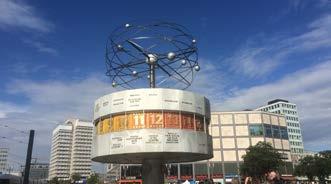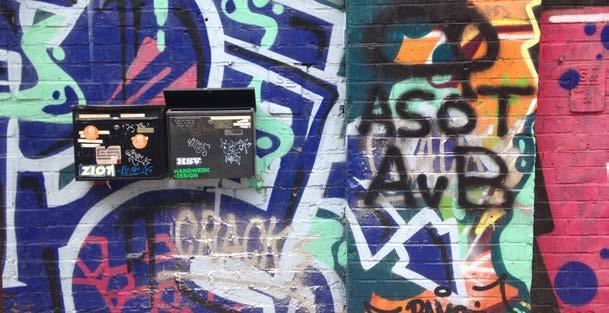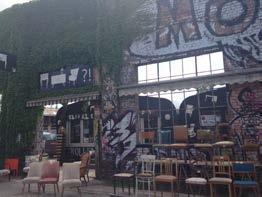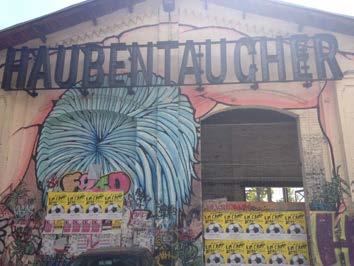
13 minute read
The Streets
from The Berlin Bunch
THE STREETS OF BERLIN
PHOTO: R.A.W., page 36
Advertisement
Ku’damm

Situated in West Berlin, Kurfüstendamm, more commonly known as Ku’damm, is a popular shopping strip in the city. This part of Berlin defnitely feels different, with its sleek, modern buildings. There are many places to get your shopping fx such as H&M, Forever 21, Adidas and various other clothing stores. If you are looking for the perfect Berlin souvenir to bring home, this would be the place to get it. There are plenty of places to eat as well, with big chains like Starbucks and McDonalds, as well as some local currywurst and Italian restaurants. The Europa Centre, which is a big shopping mall can also be found on Ku’damm where there is even more shopping to be had, although it is not as nice as you might expect it to be. The Kaiser Wilhelm Memorial church is close by, located at the corner of Lietzenburger Straße and Kurfürstendamm. Escaping to the west has never been easier thanks to the number of U-Bahn stations within walking distance.
Kurfürstendamm,10719, Charlottenburg | kurfurstendamm.de Kürfurstendamm |€€€€€ |
Words: Ryan Stelter
Alexanderplatz

If you are lost in Berlin and have absolutely no idea where you are, just look up and you will be able to see the TV Tower which will guide you directly to Alexanderplatz. Alexanderplatz is one of the most important squares in Berlin. It is generally crowded with wandering tourists, street performers and local people going about their daily routines. The importance of this square resides in the fact that it is a transportation hub as the S-Bahn and U-Bahn lines run from here. Apart from being a great place for transportation, you can fnd lots of shops like Primark, Decathlon and Alexa (the largest shopping mall in Berlin). If you are looking for some entertainment, there’s a cinema and bowling alley. All around Alexanderplatz you can fnd coffee shops, fast food stands and restaurants, however you can fnd places nearby that will have a nicer view and not only the tram lines, trash or people passing by. It is just a short walk to Museum Island from here. Don’t forget to visit the Weltzeithuhr (world time clock), which shows the time in different parts of the world and street musicians can usually be found nearby.

Potsdamer Platz

Formerly the area of 1920s buzzing activity and then a desolate wasteland during the Cold War, there is some interesting history about how this place was reinvented. It wasn’t until after 1989 that international investors rebuilt it. There was controversy and a lot of debate over what architectural style of buildings would eventually tower over the people. It was here that Berlin began tackling how to reunite the people. Transportation systems, previously separate, had to now come together. Several investors around the globe wanted to have a part of rebuilding such an important city.
Nowadays, locals can be seen heading to work at their corporate offces. Its towering modern buildings create a contemporary atmosphere. This is clearly a more high-end side of Berlin, as several of the buildings are businesses. For the traveler, there is a mall, a theater, and art exhibitions at the Daimler Atrium. There are also a few cafes and shops. It’s also here where Panorama Point is located, which is a good place to take the perfect picture.
Potsdamer Platz,10785, Mitte | potsdamerplatz.de Postdamer Platz |€€€€€ |
Words: Gabrielle Archibald
Unter den Linden

Unter den Linden stretches approximately 1.5 km from Brandenburg Gate to Schlossbrücke Bridge. The street’s location at the heart of old Berlin means that it’s quick and easy to get to if you fancy a detour. The street is littered with cafés and restaurants, so you’ll never be far from a refreshing drink or a schnitzel. Though it might not exactly be a main tourist attraction, if you’re interested in Germany’s military history then you might want to head over to the Neue Wache memorial (New Guardhouse) and the Zeughaus, the 17th century building which now houses the Museum of German History. Fans of George Clooney and Nicole Kidman may also want to pay a visit to Madame Tussauds which can be found on the western end of the boulevard. Unfortunately, Unter den Linden is currently undergoing a lot of construction which might obstruct any photos you take, though it’s worth trying to get a good view of the Berliner Dom.
Unter den Linden, 10117, Mitte | Brandenburger Tor |€€€€€ |
Karl Marx Allee

Built as a showcase of socialist power in the 1950s, Karl Marx Allee is a 90 m wide, 2 km long street leading from Frankfurter Tor to Strausberger Platz in the centre of former East Berlin. Without knowing its history Karl Marx Allee is not immediately noteworthy, though there are some interesting sights along what was once the most famous street in the GDR. Between Alexanderplatz and Strausberger Platz is Kino International, a listed cinema with a large glass dome. Opposite is Café Moscow, another listed building with a life size model of Sputnik over the entrance. Once one of the most well-known restaurants in the GDR, it is now an events centre. The street is lined with restaurants, cafés and shops and of particular note is Café Sibylle, one of the frst cafes on the street over 50 years ago. Today it also has an exhibition on the history of the street. Unless you are specifcally interested in socialist architecture, you’re not likely to plan a dedicated trip to the Allee. However, its proximity to Alexanderplatz means you might end up passing through, in which case it’s worth taking a moment to admire the classic socialist apartment blocks and imagine the military parades of the GDR.
Karl Marx Allee, 10178 | Mitte | Strausberger Platz | €€€€€ |
Words: Zoë Charlesworth
Nikolaiviertel

Nikolaiviertel is Berlin’s oldest quarter and residential area, dating to the 13th century, and is only fve minutes walk from Alexanderplatz. Like most of Berlin, it was severely damaged during the Second World War and was reconstructed in 1987 as part of the city’s 750th anniversary celebrations. The result is a weirdly wonderful mixture of different architectural styles and imitations: for example, the medieval church and streets are juxtaposed with neo-classical decorations and stucco exteriors. Nikolaiviertel is home to many artsy shops and boutiques selling handmade goods produced by local artisans and designers, but remains unpretentious and free of hipsters. Many of these shops also sell the usual mass-produced “I <3 Berlin” souvenirs found throughout the city – only in bohemian Nikolaiviertel does this not seem out of place. There are also museums and lots of restaurants and cafes selling traditional German food; the ones by the river provide a great setting for chilling, drink in hand, on a sunny day. However, because the area is quite touristy the food and drink are more expensive than most of Berlin. Regardless, the area makes a refreshing change from the bustling modernity of the rest of the city and is the place to go if you’re looking for unique gifts and mementos of your time here.

100 &200 Bus

Want a tour of Berlin but don’t want to pay exorbitant fees for a day-pass on the tourist buses? The 100 and 200 buses do parts of the same route as the tourist buses, but for a fraction of the price. Used by locals and tourists alike to get around they go around the main tourist destinations and central Berlin attractions, such as Museum Island and Alexanderplatz.
Like the tourist buses, the 100 and 200 run very frequently – between fve and ffteen minutes usually – and so it is very easy to “hop on and off” at the various sites. The buses do not have the same route: the 200 goes further east visiting sights such as Potsdamer Platz and the Philharmonie music hall, while the 100 goes past major sights such as the Victory Column and the Reichstag. Both buses stop at Berlin Central Bus Station, which is near the Zoo and the shopping district at Ku’damm; their exact routes can be found on the website. However, the cheaper price does mean there are fewer features: for example, unlike the tourist buses, the 100 and 200 do not have multilingual commentaries identifying the different sights or their histories. Neither is it possible to do a round trip on a Single ticket – but you can still buy many Singles for the price of an all-day pass for the tourist buses. To see the most sights and make the most of your journey, it is recommended getting Bus 200 at Alexanderplatz to the Zoo, and then switching to Bus 100 and doing the full line from there. Don’t bother going on Bus 200 past Friedrichshain as there is nothing of interest there. For a clearer view of the sites double-deckers are defnitely worth waiting for.
Hardenbergplatz 11, 10623 | Mitte | Bus 100, 200 Bahnof Zoologischer Garten | € Varies
Words: Kait Macdonald
Gendarmenmarkt

Gendarmenmarkt is a large square in the centre of Berlin, famous for its three grand buildings and its Christmas market. Despite the many people passing through, it has a serene atmosphere thanks to the wide open space and the elegant architecture. At either side of the square are two churches with identical domed towers, the Deutscher Dom and the Französischer Dom, built in the 1700s. Between the two churches is the Konzerthaus, built in 1821 as a theatre. All three original buildings were reconstructed after being destroyed or severely damaged during the Second World War.
The Französcher Dom now houses the Hugenot Museum, telling the story of French religious refugees in 1685 and a viewing platform at the top offering panoramic views of the city centre. In the Deutscher Dom there is a free exhibition on the development of German parliamentary democracy.
English audio guides are available but the exhibition text is in German. Unless you have a particular interest in the two museums, the churches themselves probably don’t justify a visit, however the square is well worth wandering through, especially considering its central location and proximity to other sites such as Museum Island and Brandenburger Tor.

Words: Zoë Charlesworth
R.A.W. Gelände

WORDS: MILAN CATER
R.A.W. is a sociocultural experiment that embodies modern day Berlin. Since the wall came down in 1989 an eclectic assortment of artists and creatives focked to Berlin from all over the world and began to turn the city anew: Berlin is flled with power plants turned techno temples, abandoned airports that became sports parks, churches that became art galleries and uninhabitable apartments that became manmade beaches. R.A.W. is just that; previously a train station consisting of a wide collection of derelict graffti-covered buildings, bunkers and warehouses, littering a street just off the popular Revaler Straße in Friedrichshain whic have been put to good use by the creatives of Berlin. Street food, feamarkets,clubs, beach bars, bouldering centres, and best of all a lot of amazing graffti by taggers and well known artists alike can be found at R.A.W. What you won’t fnd are many Berliners. Rather than a local hangout, R.A.W. is a place where anyone and everyone fts in, a countercultural space for the travellers of the world. Food Mama Burrito & Sons is a quirky burrito food truck serving up hefty portions of classic tortilla burritos with black beans, a spicy chilli, cheese and veg with many twists you can add. There are options for the meat lovers as well as vegan options, in a small and large size (although the small isn´t very small!) that will defnitely leave you satisfed! Other well-established food stalls in RAW include Holi Indian Street Food, Emmapea Vegan Street Food (a place with ample outdoor seating space) and What A Wurst for a good old currywurst after a few hours of dancing. Sport For those who like to keep on their toes, head over to Der Kegel, a partially outdoor bouldering centre with a café, or to Skatehalle Berlin, a very large indoor skateboarding hall. If sport isn’t your thing, have a look around these building anyway just to admire the amazing graffti adorning their walls.




Day Chilling Although R.A.W. has a lot more nightlife venues than anything else, a few popular and atmospheric daytime beirgartens are open during the summers such as Urban Spree. Urban Spree creates a relaxed atmosphere with its beach chairs and wooden outdoor seating biergarten, surrounded by jumbles of artistic sculptures and giant blue mushrooms for shade. During the summers, Urban Spree frequently hosts live music during the day, complete with food stalls and pop-up tattoo shops for a very summer festival vibe. On a particularly hot day, Haubentaucher beach bar provides sweet relief with a pool complete with diving board and poolside lounging chairs, and large screens showing football or playing relaxing slow paced techno music.

Other Stuff R.A.W. is flled with dozens of places, so if you have the time don’t limit yourself to exploring it for just one day or night. Other interesting things to do in this hub include watching a flm at the open air cinema (freiluftkino) or buying some second hand furniture at the Flohmarkt am RAW every Saturday and Sunday. Nightlife R.A.W. is the place to go if you’re looking to dance to good techno music all night long without the long lines or pricey entry fees of mega clubs like Berghain or Tresor. The White Rabbit is a small club often putting on silent disco nights, indoor and outdoor if the weather allows. Frequented by interesting characters, go there to dance and people watch but NOT to buy drinks, as their bar menu is on the pricier side.


For cheap cocktails, really good techno and a place to dance well into working hours, go to Cräck Bellmer. While many of Berlin’s clubs are reknowned for opening on Friday and closing Monday afternoon, Montag auf Cräck is one of the best and only nights out to be had on a Monday night every week if you’re looking to continue the party. A series of delicious cocktails starting at just 5.00, quality resident DJs and a crowd that is truly there to dance all night creates an electric atmosphere for such a small venue.
Take a short break from techno and head to Badehaus Szimpla: connected to the well known Szimpla Kert ruin bar in Budapest, this venue often hosts live music of all genres from R&B to drum and base, as well as frequently hosting open mic nights. Regular performers such as The Swag Jam every Tuesday reel in the crowds, keeping them there until early hours of the morning.
99 Revaler Straße Warschauer Straße raw-tempel.de





